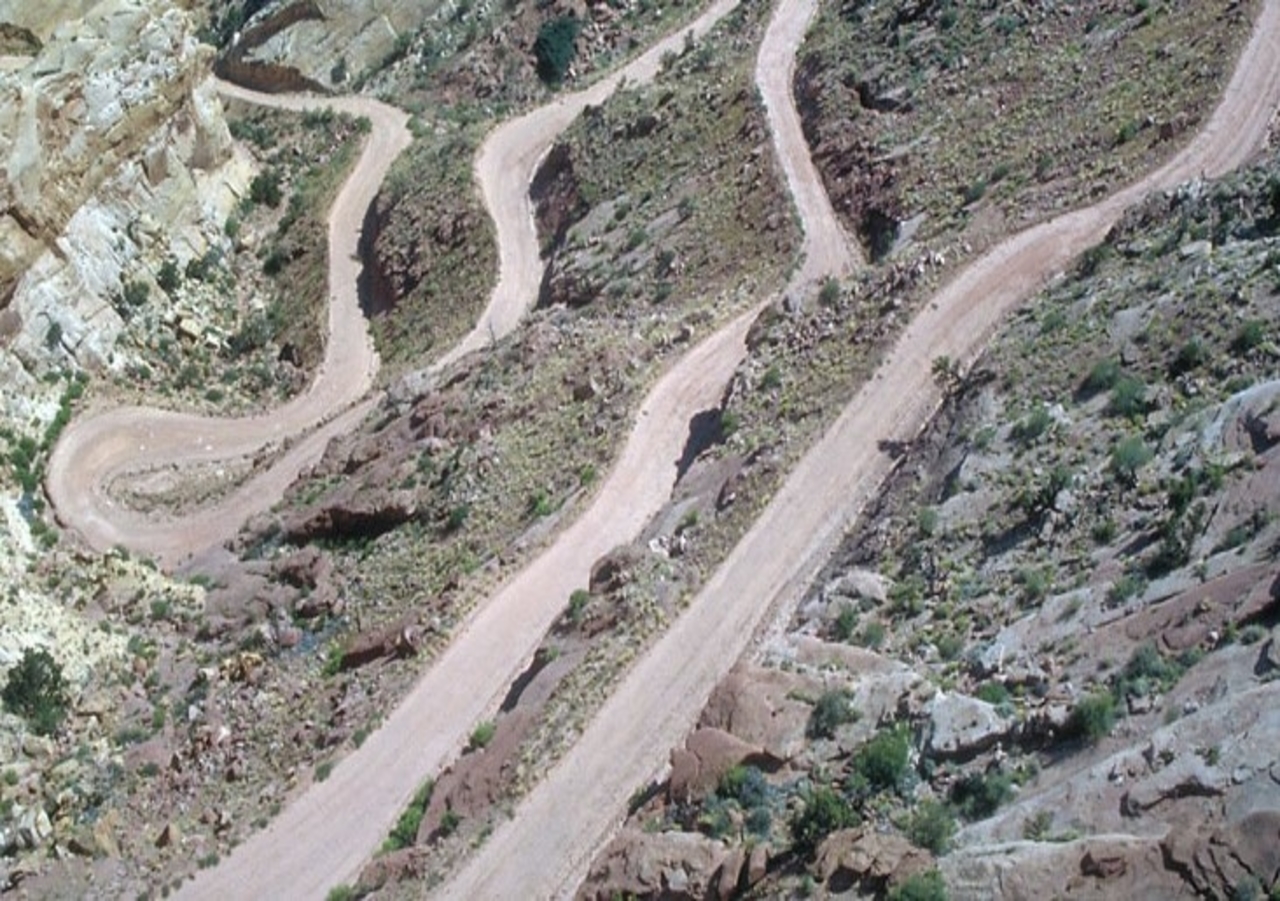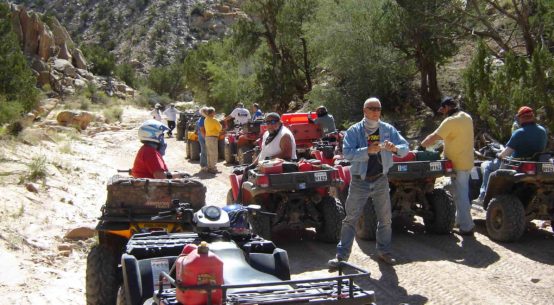
Steep and narrow switchbacks are often found off in the hinterlands in places where ATVs and Motorcycles have been the only vehicles to venture. These trails are often times a test of your personal bravery and skill as an ATV driver. The slightest misjudgment may result in seeing your machine go head over teakettle down the mountainside while customizing the front and rear racks, handlebars and wheel alignment on your ATV with each new bounce. Not to mention the personal injury that you may experience in the whole ordeal.
Great caution is in order while on switchbacks.
For the sake of our ATV community let us establish a few rules, shall we? These are not rules with jail time for disobedience, but rules of good judgment and courtesy.
Riders coming down the hill have gravity and inertia as their companion. Some ATVs with automatic transmissions have no compression breaks to slow them going down a hill. That means that their brakes are the only means of keeping them on the trail. They stand the greatest risk of injury and possible mishap. For the sake of common courtesy let us grant the right of way to those riders coming down a hill, rather than to those climbing the hill.
When approaching a switchback climb, in many instances, it is possible to see, or hear, if there are other riders descending the hill. Whenever possible, those riders ascending (climbing) the hill should wait at the bottom of the hill or at some other point where those descending (coming down) can pass without restriction or problem.
In some cases it is not possible to stop at the wide place at the bottom of the hill. You may not be able to hear or see oncoming traffic in your climb. This is why it is important to cooperate.
Strategy for Making the Hairpin Turns
If ascending or descending, either direction, start on the outside, cut across the bottom of the curve and come out wide on the other side. This will make the turn as wide and controlled as possible. Keep in mind also that 4 wheel drive machines don’t employ the rear end slide as well as the two wheel drive ATVs. (see the article on ATV Handling)
Climbing Switchbacks
When climbing a steep switchback one rider, the lead rider, should traverse a section of the trail to the next hairpin turn. On arriving at the hairpin turn the lead rider should visually scan the trail to the next hairpin turn before engaging that section of the trail. If there is no oncoming traffic then the lead rider can proceed to the next hairpin turn. The following rider stays at the previous hairpin turn until they can see that their lead rider has vacated that location for the next point. This is an indication that the trail is clear ahead. The following rider may then proceed up the trail. This would be true of each subsequent rider in a group.
The hairpin turns are usually the only location on the trail where two ATVs could safely pass one another. However if some other trail feature is more appropriate for that purpose, be sure to utilize the safest possible location for that purpose.
Communication between riders can be a very important requirement. It may be a long distance between hairpin turns and it may not be possible to visually see one hairpin turn from the other. The use of FRS radios under such circumstances can offer real advantages to keep riders in coordination with one another and keep the safety at a maximum. REMEMBER that ATVers use the channels in the FRS channel 5 band (0-38) for radio communications.
Do not attempt traversing a section of a switchback that already has a rider on it, coming in either direction. Switchbacks are usually too narrow to permit passage of two machines on the trail. It could cause one rider to back down to the hairpin turn to permit the other rider to pass. This would be very dangerous and difficult. Why should the climbing rider back down? Simply because it is extremely difficult if not impossible to back up a hill under any circumstance. Not all machines have four wheel drive. Many do not.
Advice for Descending Riders
While traversing down a switchback the same rules apply to when you are ascending a switchback. However, you will have the added obligation to maintain full control and safe speed of your ATV at all times, take extra caution with blind curves and corners.
Many older ATVs with automatic transmission do not have engine braking or compression to assist you in descending a hill. Using engine braking permits you to slow down without the use of your wheel brakes. This is done by switching the gear to a lower gear so that compression will slow your decent. This should be done in every case possible to avoid using your brakes to the point of overheating. It is true, you can apply your brakes so much that they will overheat and this causes a glaze to form on your brake pads, especially if you have drum brakes. Even disk brakes can experience this when overhead. However, disk brakes are more inclined to dissipate the heat more readily and reduce the occurrence of glazing. When this glazing happens the brakes will not slow you with such ease and may not stop you at all.
While descending a trail, if you begin to smell a strange smell that you might associate with burning tires or maybe even a skunk, it may be your brakes overheating and glazing and not a skunk. If this occurs you should quickly find a safe place to stop your ATV where others can pass you, both the ascending and descending and let your brakes cool off for at least 20 to 30 minutes before attempting to go down the hill to the bottom. You will need your brakes do not abuse them. If it is possible to stop your ATV at a place where you will not have to lock your brakes on please select that place. To cool your brakes more quickly you will need to have them disengaged. This will permit the space between the brake pad and the brake drum to dissipate the heat more readily. Block your tires with a rock or log or some other obstacle to permit your machine to sit with the brakes disengaged. Block the tires so that the ATV won’t roll away from you before you disengage the brakes.
While we have agreed here that descending riders have the right of way, if you come to a hairpin turn and find that someone is already coming up the next section of the trail, that rider has the right of way. You should stay at that point in the hairpin turn, making room for the climbing rider to pass unobstructed, until the climbing rider has passed you, then you may proceed down, provided that a subsequent rider has not already started up that section of the switchback. Not everyone will have read this and become educated in the finer points of courteous ATV riding.
Switchback Communication
In the absence of ample space on the trail for two machines coming from opposite directions to stop and chat, it is a good idea to use the appropriate hand signals as you pass each rider on the trail.
Summary
- Switchbacks with hairpin turns on steep terrain require special caution and self-restraint.
- Make each turn as wide as the trail will permit for increased control.
- Use FRS Radios on channel 5 to communicate between riding partners.
- Each section of a switchback should be attempted by only one rider at a time.
- Climbing riders should stop at each hairpin turn to inspect the next section of trail for oncoming riders.
- Priority is given to descending riders, but the first rider on a section of trail has the right of way and the section should not be attempted until it is clear of other riders.
- Use hand signals to communicate with oncoming riders.
- Use low gears to descend to prevent overheating of brakes.
- Allow your brakes to cool down by stopping occasionally as you descend.
- Use common courtesy and kindness at all times.




